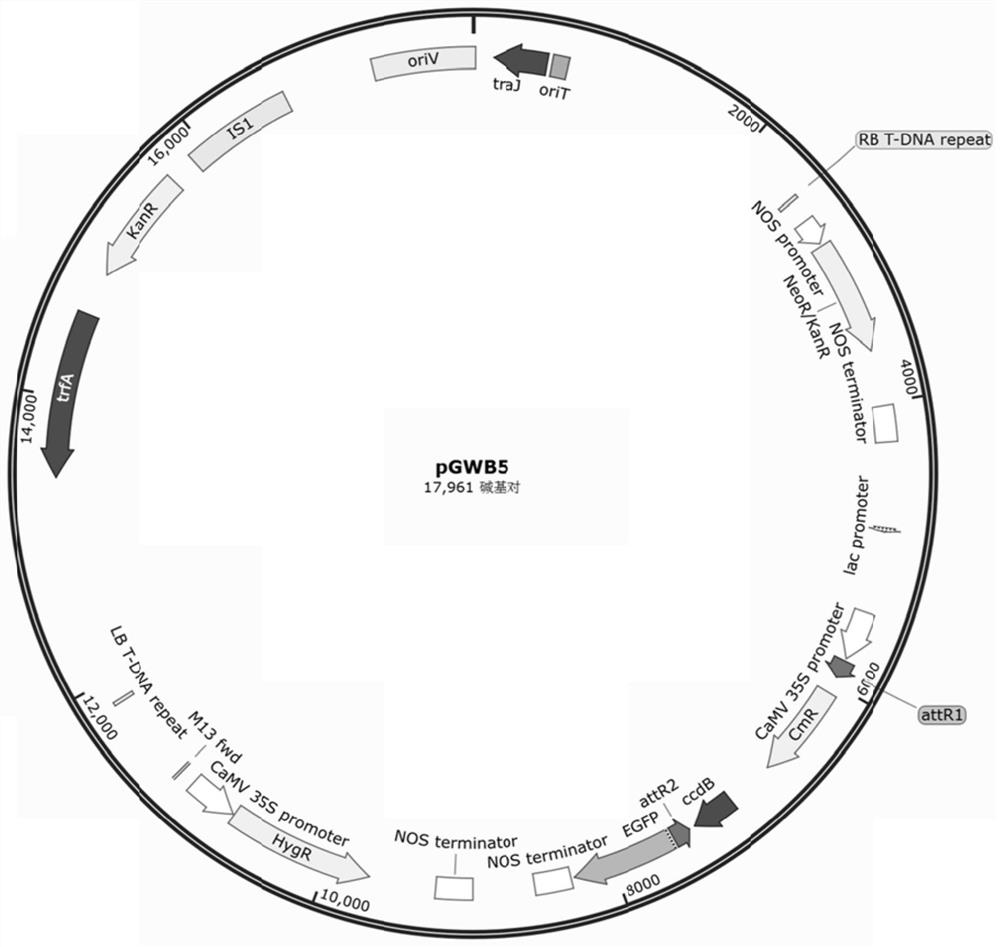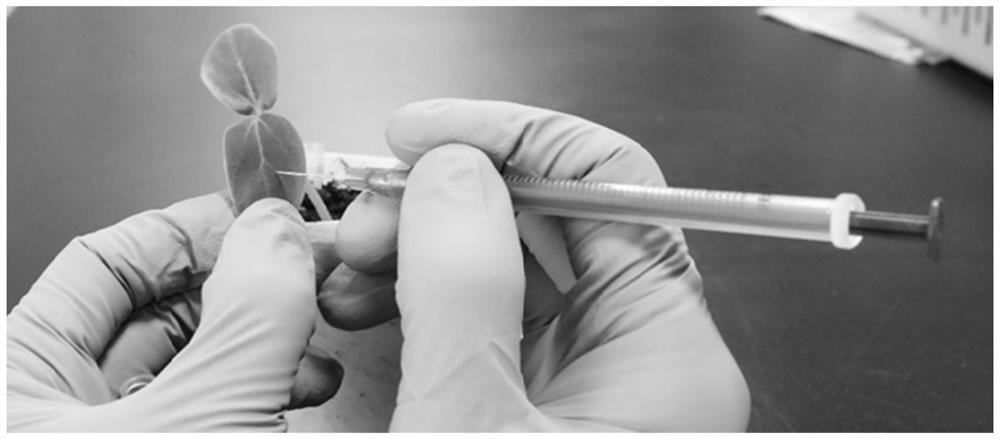Application of cucumber light-harvesting chlorophyll a/b binding protein CsPS1 to resisting phytophthora melonis
A technology for combining proteins and chlorophyll, which is applied in the field of plant molecular biology and plant genetic engineering, and can solve the problems of unsatisfactory chemical control effect and economic loss, etc.
- Summary
- Abstract
- Description
- Claims
- Application Information
AI Technical Summary
Problems solved by technology
Method used
Image
Examples
Embodiment 1
[0041] Example 1 Construction of Cucumber CsPS1 Gene Overexpression Vector
[0042] Cucumber CsPS1 gene belongs to light-harvesting chlorophyll a / b binding protein gene. Previous studies have shown that light-harvesting chlorophyll a / b binding proteins play an important role in plant development, plant stress, especially abiotic stress. The full length of the cucumber CsPS1 gene CDS was constructed into pGWB5 (the plasmid map is attached figure 1 As shown), the overexpression vector was obtained; the cucumber gene CDS non-conserved segment 207bp length fragment and its complementary fragment were constructed on pK7GWIW (plasmid map as attached figure 2 shown), and obtained on the gene silencing vector.
[0043] The amino acid sequence of cucumber CsPS1 protein is (267aa):
[0044] MAASSMALSSPSFAGQAVKLSPTASDLLGEGRITMRKTAGKPKPVSSGSPWYGPDRVKYLGPFSGEPPSYLTGEFPGDYGWDTAGLSADPETFAKNRELEVIHSRWAMLGALGCVFPELLSRNGVKFGEAVWFKAGSQIFSEGGLDYLGNPSLVHAQSILAIWACQVVLMGAVEGYRIAGGPLGEITDPIYPGGS...
Embodiment 2
[0051] Example 2 Constructing a Cucumber Cotyledon Model of Transient Overexpression / Gene Silencing
[0052] (1) The overexpression vector and the silencing vector in Example 1 were respectively transformed into Agrobacterium GV3101, and cultured upside down on the corresponding resistant medium for 48-72 hours.
[0053] (2) Pick a single clone and add it to 4 mL of LB medium containing the corresponding antibiotics and rifampicin, shake the bacteria at 180 rpm for 24-36 hours at 28°C.
[0054] (3) Add fresh LB medium containing corresponding antibiotics and rifampicin at a ratio of 1:100, shake the bacteria at 28°C and 180 rpm until the OD600 value is about 3.0.
[0055] (4) Collect the bacteria by centrifugation at 3000rpm for 5 minutes, resuspend the bacteria with a suspension (10mM MES, 10mM MgCl2), adjust the OD600 value to about 0.4, and add 200mM acetosyringone.
[0056] (5) Stand at room temperature for 3-5 hours.
[0057] (6) Prick a needle hole on both sides of the...
Embodiment 3
[0070] Example 3 Cucumber cotyledon disease resistance experiment
[0071] For the cucumber cotyledon model with transient overexpression of CsPS1 successfully constructed in Example 2, the cucumber cotyledon model of CsPS1 gene silencing, and the wild-type cucumber cotyledon, the cucumber seedlings after injection were cultured in the dark for 12 hours and then cultured in the light at 22°C for 3 to 4 days. Cucumber cotyledons were isolated and inoculated with Phytophthora cucurbiti, and cultured in a culture dish at 28°C for 24 hours in the dark.
[0072] The resistance function of the target gene to the disease was judged according to the size of the lesions on the isolated cucumber cotyledons of different treatments. The results are shown in the attached Figure 5 shown.
[0073] The results showed that transient overexpression of CsPS1 gene in cucumber cotyledon can significantly enhance the resistance of cucumber cotyledon to blight compared with the control, while tran...
PUM
 Login to View More
Login to View More Abstract
Description
Claims
Application Information
 Login to View More
Login to View More - R&D
- Intellectual Property
- Life Sciences
- Materials
- Tech Scout
- Unparalleled Data Quality
- Higher Quality Content
- 60% Fewer Hallucinations
Browse by: Latest US Patents, China's latest patents, Technical Efficacy Thesaurus, Application Domain, Technology Topic, Popular Technical Reports.
© 2025 PatSnap. All rights reserved.Legal|Privacy policy|Modern Slavery Act Transparency Statement|Sitemap|About US| Contact US: help@patsnap.com



